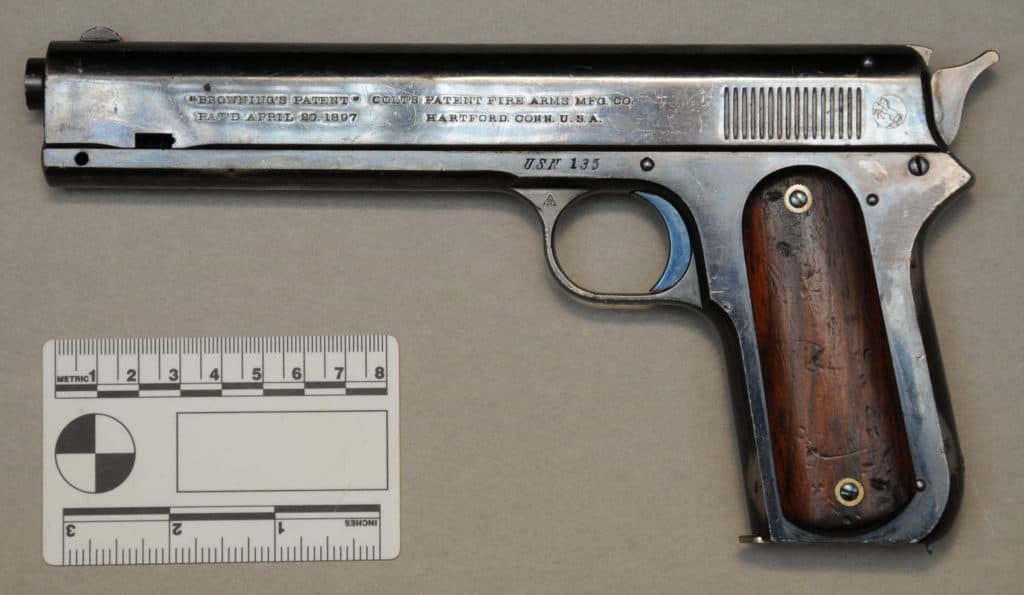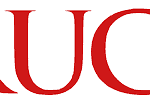
"Pistol US Colt M1900" by Naval History & Heritage Command is licensed under CC BY 2.0 .
Introduction
The emergence of the Colt Model 1900, or M1900 Pistol, marked a pivotal moment in the history of firearms. As the first semi-automatic pistol produced by Colt’s Manufacturing Company, this groundbreaking firearm played a key role in shaping the evolution of modern handguns. Commonly referred to as the Colt .38 Automatic Pistol, the Model 1900 introduced design principles that not only influenced subsequent Colt models but also became foundational to semi-automatic handgun design worldwide.
Developed through a collaboration between John Moses Browning, one of the most prolific firearm inventors in history, and Colt’s Manufacturing Company, the Model 1900 represented an early effort to replace revolvers with self-loading pistols. Though production lasted only five years, the Colt Model 1900 left an indelible mark on the firearms industry.
This article provides a comprehensive exploration of the M1900’s development, technical specifications, performance, military trials, and legacy, ensuring a fully authoritative and historically rich examination of this influential pistol.
Origins and Development of the Colt Model 1900
John Browning and the Evolution of the Semi-Automatic Pistol
By the late 19th century, the concept of self-loading pistols was beginning to take shape, with innovators such as Hugo Borchardt (inventor of the Borchardt C-93), the Mauser brothers (C96 Broomhandle), and Georg Luger (Luger P08) pushing the boundaries of handgun design. However, the most enduring innovations in semi-automatic pistol technology came from John Moses Browning, whose firearms would dominate the 20th century.
Browning had initially experimented with simple blowback-operated pistols, but he soon recognized the limitations of this mechanism for larger-caliber handguns. By 1897, Browning had developed a short-recoil, locked-breech system, which used a pivoting swinging link to control the motion of the barrel and slide. This system was patented on April 20, 1897 (U.S. Patent No. 580,924) and would become a defining feature of his later designs, including the legendary Colt M1911.
Recognizing the promise of Browning’s design, Carl Ehbets, Colt’s patent and design expert, persuaded the company to enter into an agreement with Browning. Colt would manufacture the pistols under Browning’s patents, with a royalty payment of $1 per unit sold and the inscription “Browning’s Patent” on each slide.
Colt Model 1900: Design and Technical Specifications
The Colt Model 1900 was chambered for the .38 ACP (Automatic Colt Pistol) cartridge, a semi-rimmed, straight-walled round that offered higher velocity and energy than contemporary revolver cartridges. The pistol’s design set several industry standards that are still observed today.
Key Specifications
- Caliber: .38 ACP (not to be confused with .38 Super, a later high-pressure variant)
- Bullet Diameter: .356 inches (9.04mm)
- Case Length: .900 inches
- Overall Cartridge Length: 1.280 inches
- Muzzle Velocity: 1,260 feet per second (fps) with a 130-grain full metal jacket (FMJ) bullet
- Operating Mechanism: Short-recoil, swinging-link locked-breech system
- Magazine Capacity: 7 rounds (single-stack, detachable box magazine)
- Overall Length: 8.25 inches
- Barrel Length: 6 inches
- Weight: ~35 ounces (unloaded)
The M1900 was also notable for its slide-operated action, which replaced earlier bolt-based systems used in pistols like the Mauser C96. This design innovation directly influenced the evolution of modern semi-automatic handguns.
Sight Safety Mechanism: A Short-Lived Experiment
One of the most unique but ultimately flawed features of the M1900 was its sight safety mechanism. This innovative but impractical design combined the rear sight with a manual safety, requiring the shooter to push the rear sight forward to disengage the safety and make the pistol ready to fire.
Feedback from users and military evaluators revealed that the sight safety was cumbersome in real-world use. Consequently, Colt began phasing it out in 1901, replacing it with a standard rear sight and a filler plug in its previous location. Today, M1900 pistols that retain their original sight safety mechanism are considered rare collector’s items.
Performance and Military Trials
The .38 ACP cartridge provided increased muzzle velocity over traditional revolver rounds like the .38 Long Colt, but concerns over its stopping power emerged early on. This was particularly evident in the Philippine-American War (1899–1902), where U.S. forces found that smaller-caliber bullets lacked the ability to effectively incapacitate Moro insurgents.
The Thompson-LaGarde Tests (1904)
In response to concerns over stopping power, the U.S. Army conducted the Thompson-LaGarde tests in 1904, which demonstrated that larger calibers were necessary for effective military sidearms. This led to the eventual development of the .45 ACP cartridge and the adoption of the M1911 pistol.
Despite its limited U.S. military adoption, the Colt M1900 was issued in small numbers to various law enforcement agencies and foreign governments, including Argentina, China, Mexico, and the Philippines.
Influence on Future Firearms
Despite its relatively short production run, the Colt Model 1900 had a profound impact on handgun design. Several core features of the Model 1900 influenced later firearms, including:
- The short-recoil, locked-breech system, which became standard in most modern semi-automatic pistols.
- The slide-operated mechanism, an innovation that replaced the bolt-based designs of earlier semi-automatic pistols.
- The integrated magazine within the grip, which set a precedent for pistol ergonomics and functionality.
Successor Models: The Colt Model 1902 and Beyond
Following the Model 1900, Colt introduced several refinements in the Colt Model 1902, which featured a longer grip frame, a more robust slide, and an improved trigger mechanism. These design improvements paved the way for the Colt Model 1905, the direct predecessor of the M1911.
Conclusion: A Landmark in Firearms History
The Colt Model 1900 represents a landmark in semi-automatic pistol development. Designed by John Moses Browning and manufactured by Colt’s Manufacturing Company, this pioneering firearm laid the groundwork for modern handguns. While its production run was brief and its adoption by the U.S. military was limited, its technical innovations influenced generations of firearms, culminating in the adoption of the Colt M1911, one of the most iconic handguns of all time.
Today, surviving examples of the Colt M1900 are highly prized by collectors, especially models retaining the original sight safety mechanism. As a pivotal piece of firearms history, the Colt M1900 remains a testament to the ingenuity of John Browning and the enduring legacy of Colt’s Manufacturing Company.
If you know of any forums or sites that should be referenced on this listing, please let us know here.




